People Hurting Birds
Avian pathologists have determined that the deaths of 63 birds in downtown Austin, Texas, this month were the result of natural causes. Texas A&M University pathologists examined nine of the birds found dead on 8 January and determined they died because of parasites and a drop in temperature, the Austin American-Statesman reported Friday. "These birds were heavily parasitized by multiple species of parasites," said Lelve Gayle, the executive director of the Texas Veterinary Medical Diagnostic Laboratory. "These birds were sick." GrrlScientist note: this sounds so incredibly unlikely to me .. parasites killed at least 63 birds of different species nearly simultaneously in close proximity to each other in 40 degree weather? Puhleeze, get serious, do they think we all just fell off a turnip truck? It sounds like poisoning to me. Further, as you will note in the following article, a duck stayed alive for two days in a refrigerator after being shot in several places by a hunter, which makes this claim even more suspect.
A duck in Florida survived gunshot wounds and a two-day stay in a refrigerator. A hunter shot the duck (probably a female ring-necked duck), wounding it in the wing and leg. Believing the bird was dead, he left it in his fridge at his home in Tallahassee. The hunter's wife got a fright when she opened the refrigerator and the duck lifted its head, a local veterinarian said. Staff at the Goose Creek Animal Sanctuary who are treating the bird said it has a 75% chance of survival.
High-altitude ski runs are seriously affecting Alpine birds, ecologists have found for the first time. Working at the top of the Susa Valley - the site of last year's Winter Olympics - and around the Monte Rosa and Monte Bianco massifs in the western Italian Alps, the team measured the number of birds and the number of bird species at seven sites between 2010 metres and 2892 metres. They found that, compared with natural grassland, ski pistes had fewer species and lower numbers of birds. Areas next to ski pistes also suffered, supporting lower numbers of birds. They found fewer arthropods on the ski pistes, suggesting that a shortage of food may be responsible for so few birds occurring on these sites. "More than one-quarter of the 26 bird species in this study - including the rock partridge, the red-billed chough and the wheatear - are classified as species of European conservation concern," Professor Rolando says. Rersults appear in the January issue of the peer-reviewed Journal of Applied Ecology.
People Helping Birds
Eradication of black rats from three small islets that host important breeding Eleonora's Falcon, Falco eleonorae, and seabird colonies in the Northern Sporades National Marine Park, Greece, has had immediate conservation benefits. Prior to the eradication, up to 30% of Eleonora's Falcon eggs and nestlings were eaten by rats, but subsequently neither the falcons, nor the breeding seabirds -- mainly Mediterranean Shags, Phalacrocorax aristotelis desmarestii, and Yellow-legged Gulls, Larus cachinnans -- have suffered rat predation.
A new Spix's Macaw Cyanopsitta spixii (pictured), has hatched at Loro Parque on Tenerife. This is an endangered species and the new birth brings the species' numbers up to only 73. The new bird's sex is still not known, but has doubled his or her weight in the few days since the birth on a diet of cereal porridge, vitamins, enzymes and egg white. The elegant Spix Macaw is originally from Brazil and the foundation hopes numbers in the future will allow the birds to be released back into the wild.
 There may be more to parrot talk than simple mimicry, suggests the behaviour of one precocious bird. For the first time, a grey parrot shows he can imitate what he sees and hears. The bird, Alex Psittacus erithacus (pictured), can also create new word labels for objects by combining words he already knows. For example, he calls a juicy red apple, which appears to remind him of bananas and cherries, a "banerry". Irene Pepperberg, a parrot expert who is now a visiting professor at the Massachusetts Institute of Technology's Media Lab, explains that recombination of units, meaning words and sounds, represents a novel act that involves cognitive processing. So Alex is imitating and not mimicking. Pepperberg also believes Alex has an awareness of speech sounds and the ability to segment words, skills once attributed only to people.
There may be more to parrot talk than simple mimicry, suggests the behaviour of one precocious bird. For the first time, a grey parrot shows he can imitate what he sees and hears. The bird, Alex Psittacus erithacus (pictured), can also create new word labels for objects by combining words he already knows. For example, he calls a juicy red apple, which appears to remind him of bananas and cherries, a "banerry". Irene Pepperberg, a parrot expert who is now a visiting professor at the Massachusetts Institute of Technology's Media Lab, explains that recombination of units, meaning words and sounds, represents a novel act that involves cognitive processing. So Alex is imitating and not mimicking. Pepperberg also believes Alex has an awareness of speech sounds and the ability to segment words, skills once attributed only to people.
Birding
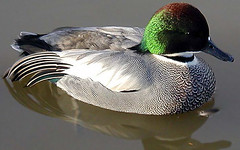 A male falcated duck, Anas falcata (pictured), native to eastern Siberia and northern China, is creating so much hype among birders that some are actually en route from as far away as Toronto and North Carolina to see him. "These hard-core birders don't mess around," said Ray Holmberg, who lives at the gated Gainsborough Homes subdivision off Irving Road in north Eugene. In fact, a falcated duck has been sighted here before, but the word seems well and truly out in the birding community this time. "This is undoubtedly the same bird that has been reappearing for four years or so now," said Alan Contreras, a local bird expert and author of the recently published "Birds of Lane County."
A male falcated duck, Anas falcata (pictured), native to eastern Siberia and northern China, is creating so much hype among birders that some are actually en route from as far away as Toronto and North Carolina to see him. "These hard-core birders don't mess around," said Ray Holmberg, who lives at the gated Gainsborough Homes subdivision off Irving Road in north Eugene. In fact, a falcated duck has been sighted here before, but the word seems well and truly out in the birding community this time. "This is undoubtedly the same bird that has been reappearing for four years or so now," said Alan Contreras, a local bird expert and author of the recently published "Birds of Lane County."
 A common grackle, Quiscalus quiscula (pictured), has been spotted on a horse ranch in the Sacramento Valley for the first time ever. David Yee, a local bird expert and a trained biologist, said because the bird has returned for four days, it is likely wintering here, meaning it could remain in the area until March. But there are no guarantees that will happen, he said. "The biggest thrill is to find a rare bird locally," he said. "I may be a world traveler, but my favorite place to bird is right here at home."
A common grackle, Quiscalus quiscula (pictured), has been spotted on a horse ranch in the Sacramento Valley for the first time ever. David Yee, a local bird expert and a trained biologist, said because the bird has returned for four days, it is likely wintering here, meaning it could remain in the area until March. But there are no guarantees that will happen, he said. "The biggest thrill is to find a rare bird locally," he said. "I may be a world traveler, but my favorite place to bird is right here at home."
Avian Influenza
An international team of researchers has found a critical clue to how the influenza virus that claimed 50 million lives in 1918 killed so quickly and efficiently. Led by University of Wisonsin Madison Virologist Yoshihiro Kawaoka, the researchers detected the virus' ability to unleash an immune response that destroys the lungs within some days, and thereby leads to death. The findings, published in the top-tier journal Nature, are important because they provide insight into how the virus was so efficiently deadly, and suggest that deaths may be prevented by early intervention if such an outbreak occurs in the future.
Indonesia reports its fifth avian influenza death this year, bringing its total to 62 deaths, while a 27 year old woman died in Egypt, bringing that country's total deaths to 11. Ominously, a tamiflu-resistant bird flu appears to have arisen in Egypt.
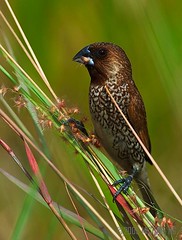 Six scaly-breasted munias, Lonchura punctulata (pictured), a popular species used as "prayer birds" that are released in Buddhist rituals to enhance a devotee's karma, were found dead in a busy shopping area, including one which tested positive for the H5N1 virus. Prayer bird species range from munias, Japanese white-eye, Zosterope japonicus, white-rumped munia, Lonchura striata, and tree sparrows, Spizella arborea, costing as little as HK$4 (US$0.50) each, to the more expensive azure-winged magpies, Cyanopica cyana, and Mongolian larks, Melanocorypha mongolica, are imported from China. The prayer birds are released en masse at Buddhist religious rites, and could spread bird flu to poultry, experts say. The government has not said whether it would consider a ban on wild bird imports but has urged Buddhist organizations not to release such birds in future.
Six scaly-breasted munias, Lonchura punctulata (pictured), a popular species used as "prayer birds" that are released in Buddhist rituals to enhance a devotee's karma, were found dead in a busy shopping area, including one which tested positive for the H5N1 virus. Prayer bird species range from munias, Japanese white-eye, Zosterope japonicus, white-rumped munia, Lonchura striata, and tree sparrows, Spizella arborea, costing as little as HK$4 (US$0.50) each, to the more expensive azure-winged magpies, Cyanopica cyana, and Mongolian larks, Melanocorypha mongolica, are imported from China. The prayer birds are released en masse at Buddhist religious rites, and could spread bird flu to poultry, experts say. The government has not said whether it would consider a ban on wild bird imports but has urged Buddhist organizations not to release such birds in future.
An Icelandic company claims that an enzyme it has found in cod could help scientists find a drug to beat avian flu. Zymetech, founded in 1996 by scientists from the University of Iceland in Reykjavik, concentrates on making pharmaceuticals and cosmetics developed from enzymes found in fish. One of the company's medical products is Penzim, a compound first identified in the digestive system of cod which in the past has been shown to help relieve a variety of conditions including skin problems such as eczema and psoriasis. Zymetech managing director Jon Bragi Bjarnason said a formulation of Penzim had been shown to destroy 99 per cent of H5N1 avian flu virus cells in an experimental culture within five minutes. The study was carried out by Retroscreen Virology, an independent research group based in London. "The results against the avian flu virus look very promising," said Professor Bjarnason, who teaches biochemistry at the University of Iceland.
Streaming Birds
 This week on BirdNote from the Seattle Audubon Society, for the week of January 22, 2007: Monday, John Burroughs, naturalist and essayist, 1837-1921; Tuesday, More about John Burroughs; Wednesday, An Owl Is Mobbed; Thursday, Why Arctic Terns have short beaks; Friday, How Feathers Insulate. BirdNotes transport the listener out of the daily grind with two-minute vignettes that incorporate the rich sounds of birds provided by Cornell University and by other sound recordists, with photographs and written stories that illustrate the interesting -- and in some cases, truly amazing -- abilities of birds. Some of the shows are Pacific Northwest-oriented, but many are of general interest. BirdNote can be heard live, Monday through Friday, 8:58-9:00AM in Western Washington state and Southern British Columbia, Canada, on KPLU radio and now also in North Central Washington state on KOHO radio. All episodes are available in the BirdNote archives, both in written transcript and mp3 formats, along with photographs. Listener ideas and comments are welcomed. [rss].
This week on BirdNote from the Seattle Audubon Society, for the week of January 22, 2007: Monday, John Burroughs, naturalist and essayist, 1837-1921; Tuesday, More about John Burroughs; Wednesday, An Owl Is Mobbed; Thursday, Why Arctic Terns have short beaks; Friday, How Feathers Insulate. BirdNotes transport the listener out of the daily grind with two-minute vignettes that incorporate the rich sounds of birds provided by Cornell University and by other sound recordists, with photographs and written stories that illustrate the interesting -- and in some cases, truly amazing -- abilities of birds. Some of the shows are Pacific Northwest-oriented, but many are of general interest. BirdNote can be heard live, Monday through Friday, 8:58-9:00AM in Western Washington state and Southern British Columbia, Canada, on KPLU radio and now also in North Central Washington state on KOHO radio. All episodes are available in the BirdNote archives, both in written transcript and mp3 formats, along with photographs. Listener ideas and comments are welcomed. [rss].
Miscellaneous Birds
After finding a dead bird in a surprising location this week, the naturalists at Hilton Pond decided to put together a photo essay about the amazing differences and similarities between the skulls of birds. Thus, if you've ever wanted a comparative look at bird skulls, the current installment of "This Week at Hilton Pond" provides that opportunity. As always, they also include some miscellaneous nature notes and a tally of all bird banded, but the most interesting list enumerates ten old American Goldfinches that returned this week to their traps.
Authorities in Western Australia are again baffled by the unexplained deaths of more than 200 birds in a small farming community. It follows the mysterious deaths of an estimated 4000 native birds at Esperance on the state's south coast in a phenomenon that has sparked worldwide scientific attention. Unlike the first incident, the dead birds at the tiny Wheatbelt town - more than 400km west of Esperance - have been identified as treemartins, similar to swallows, which are migratory insect-eaters known to enjoy moderate climates. They can be vulnerable to cold temperatures and wet conditions. "What we do know is that it was quite cold at Narembeen on the day the birds turned up," he said. "We think it was around about 16C, which is quite cold for a little bird like that."
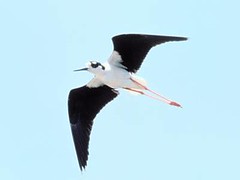 The State of California must come up with a plan for restoring the Salton Sea, but so far none of the proposals outlined by the state in its Draft Environmental Impact Report include actions to "adequately" maintain the site as a habitat for wildlife, conservationists argue. Salton Sea is an inland saline lake located in the Colorado Desert of Southern California. The Sea was created in 1905 when heavy rain and snowmelt caused the Colorado River to breach an upland dike, flooding the surrounding lowlands. The Sea covers an area of 376 square miles and is a vital refuge for over 400 bird species.
The State of California must come up with a plan for restoring the Salton Sea, but so far none of the proposals outlined by the state in its Draft Environmental Impact Report include actions to "adequately" maintain the site as a habitat for wildlife, conservationists argue. Salton Sea is an inland saline lake located in the Colorado Desert of Southern California. The Sea was created in 1905 when heavy rain and snowmelt caused the Colorado River to breach an upland dike, flooding the surrounding lowlands. The Sea covers an area of 376 square miles and is a vital refuge for over 400 bird species.
.
The Fine Print: Thanks to Mike, Mary, Ian and Ron for sending story links. Thanks in advance to Ian for catching my typos; as you probably know by now, I put a few typographical errors in these documents just so Ian can find them!
What is the point of Birds in the News? I publish BITN each week because I want to increase people's awareness of the importance of birds in our everyday lives. Birds represent many things to us; beauty, freedom, music, wildness. But everywhere, birds are coming under increasing pressure for their very survival, and by linking to news stories about birds, I hope to make the smallest impression upon the public and the mainstream media as well as our decision-makers, that birds are an important feature of our everyday lives, and that there are so many reasons that we could not do without them.
tags: Birds in the News, ornithology, birds, avian, newsletter

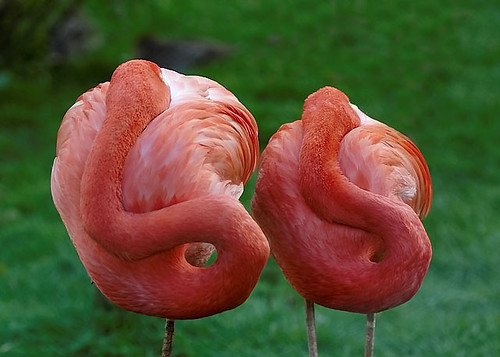
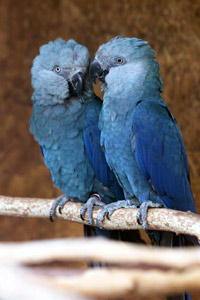

"...this sounds so incredibly unlikely to me .. parasites killed at least 63 birds of different species nearly simultaneously in close proximity to each other in 40 degree weather?"
I agree. It's been my experience that vets who are used to dealing with captive-bred birds often freak out when they see wild birds with normal levels of parasites. Thanks for another great BITN.
once again, thank you for informative newsletter... i really missed it...
I thought the parasite story seemed a little fishy. If I recall right the animal pathologist only tested the grackles.
Poisoning is possible. Businesses with outdoors areas are next to the bird's evening roost, and the businesses don't like cleaning the bird droppings. If someone has poisoned the birds it might be them.
The grackle nuisance includes not only the guano but also the raucous screaming of the birds in downtown trees (Houston has some favorite winter roosts, too, several of them around heavily-patronized bus stops, characterized by high-decibel grackle calling and hissing). It's a Bosch vision of solid-waste and audio hell. In Rice Village shopping center in Houston it is easy to spot the starling trees because, in a parking lot where parking is at an extreme premium, a whole block of spaces will be nearly empty, except for newbie cars heavily lathered in bird poop. Someone in Austin must have lost it and spread poisoned bird feed.
okay, so if the guy in FL shot the duck to begin with, why did they then take it to the vet? and isn't it standard procedure to gut/ clean a bird before you freeze it? doesn't sound like that guy should be runnin' loose with a firearm . . .
The temperatures in Austin dropped much more suddenly in November--from 87 to 38 in a day and a half. I guess the freezing temperatures at night could have been worse, though.
One more thing, the picture for the post was great! If there was not a caption I don't think I would have figured out what the pictures were birds!
I was first interested in your blog because you were a fellow BP person ;) but there is alot of great stuff on your blog. Was the title Scientist Interrupted a play on the title of the movie Girl Interrupted?
"BRAVO",(clapping...)- another GREAT post of "birdie news"!
Thanks for another great edition. On the Austin story - I agree with you and your other commenters - parasites and tempurature? Most of the species do very well in below zero tempuratues and with daily tempurature swings in the 50-60 degree range. Theoretically possible, maybe, likely, no way.
As the Secretary of the Associated Birdkeepers of Australia Inc. and spend time every 2 months looking for interesting bits and pieces for our newsletter the Communicator, I found your articles ideal for use BUT may we reprint,if so to whom do we ask for useage and who do we acknowledge.
Our members are from all over Australia and include anything with feathers
Barbara Devnie